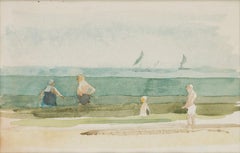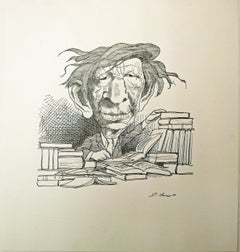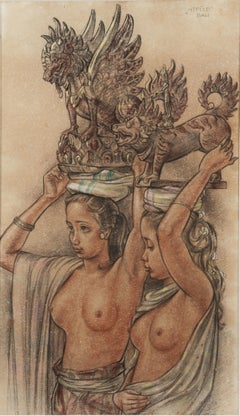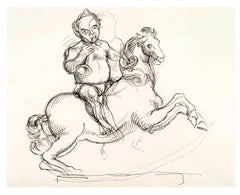David Levine Art
to
3
2
1
3
Overall Height
to
Overall Width
to
3
2
1
1
1
1
1
3
2
1
3
6,886
3,210
2,514
1,217
2
2
2
2
1
Artist: David Levine
Beach Scene
By David Levine
Located in Greenwich, CT
David Levine (1926-2009)
Category
1950s David Levine Art
Materials
Paper, Watercolor, Pencil
Rowing in Central Park
By David Levine
Located in Greenwich, CT
David Levine (1926-2009)
Category
1950s David Levine Art
Materials
Paper, Watercolor, Pencil
W. H. AUDEN
By David Levine
Located in Portland, ME
Levine, David. W. H. AUDEN. Drawing, ink on paper, 1970. Signed "D.
Levine 70, lower right, and inscribed on the verso, "Auden Look July
14, 1970," indicating that this caricature d...
Category
1970s David Levine Art
Materials
Ink
Related Items
Two Balinese Beauties (Mapeed), circa 1945
By Johan Rudolf Bonnet
Located in Amsterdam, NL
Rudolf Bonnet (1895-1978)
'Mepèèd' (Mapeed)
Signed lower right
Titled upper right
Pastel on gouache pigmented paper, 57 x 34 cm
In original carved ebo...
Category
1940s David Levine Art
Materials
Paper, Crayon, Pastel, Gouache, Pencil
Free Shipping
H 22.45 in W 13.39 in D 0.04 in
Joseph McCarthy as Baby New Year on a Hobbyhorse
By Reginald Marsh
Located in New York, NY
ink on beige
sight size: 254 x 317 mm.
PROVENANCE
Acquired directly from the artist by
Edward Laning (who inherited Marsh's studio) to
Jack Henderson...
Category
1950s Other Art Style David Levine Art
Materials
Paper, Ink
Originals-Meeting Raphael-Studies of Movement and Form-UK Award Artist- Set of 2
Located in London, GB
This set of drawings included Two Studies of Raphael's paintings in National Gallery, London where Shizico Yi learned her craft in drawings from old masters in Museums, a project she...
Category
2010s Contemporary David Levine Art
Materials
Ink, Archival Paper
Free Shipping
H 8.19 in W 17.33 in D 0.04 in
Man sitting with a cigarette, black stone on paper, siigned
Located in PARIS, FR
Rudolf Schlichter (1890-1955)
Man sitting with a cigarette
Black stone on paper
Signed "R. Schlichter" at the bottom right
51 x 30 cm
Small damages o...
Category
Early 20th Century David Levine Art
Materials
India Ink, Ink
"Great Pine", Tree Inhabited by Human in Nature, Drawing and Pigments on Paper
By Frank Girard
Located in Clermont-Ferrand, Auvergne-Rhône-Alpes
This drawing by Frank Girard is created with pigments, Chinese ink, watercolors, acrylic, and colored pencils on 300g/m2 neutral white paper. It is not fr...
Category
2010s Realist David Levine Art
Materials
Paper, Ink, Watercolor, Pigment, Acrylic, Color Pencil
H 25.6 in W 19.69 in D 0.02 in
Original-Meeting Cezanne-Studies of Movement and Form-UK Artist-Set of 2 drawing
Located in London, GB
This set of drawings included Two Studies of Cezanne's paintings in National Gallery and The Courtauld Gallery , London where Shizico Yi learned her craft in drawings from old master...
Category
2010s Contemporary David Levine Art
Materials
Ink, Archival Paper
H 8.47 in W 13.59 in D 0.04 in
Disappearances / Extinctions #1 Hélène Duclos 21st Century drawing landscape art
By Hélène Duclos
Located in Paris, FR
This drawing is part of the current exhibition entitled "The fantastic story of the liquid mountain" at Claire Corcia Gallery in Paris.
The liquid mountain is populated by living be...
Category
2010s Contemporary David Levine Art
Materials
Color Pencil, Graphite, Paper, Gouache
H 39.38 in W 27.56 in D 1.97 in
"Great Pine", Tree Inhabited by Human in Nature, Drawing and Pigments on Paper
By Frank Girard
Located in Clermont-Ferrand, Auvergne-Rhône-Alpes
This drawing by Frank Girard is created with pigments, Chinese ink, watercolors, acrylic, and colored pencils on 300g/m2 neutral white paper. It is not framed.
Through drawings, the...
Category
2010s Realist David Levine Art
Materials
Color Pencil, Pigment, Paper, Ink, Acrylic, Watercolor
H 25.6 in W 19.69 in D 0.02 in
Six Soviet Gymnasts
By Patrick Procktor
Located in London, GB
Watercolour, felt tip pen, and pencil on paper, titled (lower left), 48cm x 37cm, (70cm x 58cm framed). It is in its original frame, although the glass and mount have been replaced.
Patrick Procktor was part of an influential group of British artists in the 1960s. His early paintings were dynamic, abstract depictions of the male nude, before he established himself as one of the leading watercolourists of his generation from the 1970s His work is held in many major public collections. This work is after the soviet painting...
Category
1960s Post-War David Levine Art
Materials
Paper, Watercolor, Felt Pen, Pencil
The Argument
Located in New York, NY
Signed and inscribed on a label on the verso:
No. 1/ The Argument/ W. Cave Thomas/ 203 Camden Rd/ NW
Provenance:
Christie’s, London, 6 November 1995, lot 88.
Private Collection, London.
This powerful watercolor is a mature work by the little-known Victorian painter William Cave Thomas...
Category
19th Century Pre-Raphaelite David Levine Art
Materials
Watercolor, Paper, Pencil
French Fashion Sketch - Fur Trimmed Evening Dress
Located in Houston, TX
Unique pencil and gouache fashion sketch of a slim and flowing blue evening dress trimmed in white fur, circa 1930.
Original artwork on paper displayed on a white mat with a gold bo...
Category
1930s David Levine Art
Materials
Paper, Gouache, Pencil
Tense & Tenses – ink on paper, poem, edition, black and white
Located in Tuscany, Pisa
Lauren Ellis Matthews is a Californian-based writer, illustrator and designer. She studied Art History at Columbia University, New York and was an artist-...
Category
2010s David Levine Art
Materials
Paper, Ink
Previously Available Items
In Contemplation (Impressionist portrait of a young man)
By David Levine
Located in Wilton Manors, FL
David Levine (1926-2009). In Contemplation, 1955. Oil on panel, 6.5 x 7.5 inches; 10.5 x 11.5 inches framed.. Davis Galleries label affixed en verso. Excellent condition with no damage or restoration. Unsigned.
Biography:
Widely acknowledged as one of the greatest caricaturists of the second half of the 20th century, David Levine was best known for his drawings for the New York Review of Books (which spanned more than 40 years), Esquire, Time magazine and The New Yorker. Awarded numerous prizes for his work, which was reproduced worldwide and influenced a generation of international cartoonists, he was also an accomplished painter in watercolours and oils.
David Julian Levine was born on 20 December 1926 in Brooklyn, New York, the only child of Harry Levine, who ran a small clothing factory specialising in women’s dresses from a loft on Sixth Avenue, and Lena Isaacson, a nurse. Though not an academically strong pupil (“I didn’t do anything in school – I studied volleyball”), he excelled in drawing and wanted to become a comic-book artist like Will Eisner (creator of The Spirit). At the age of nine he won a contest sponsored by Walt Disney to draw the character Goofy and was invited to audition as an animator for the Disney studio in Los Angeles.
However, his parents decided against this and after he left Erasmus Hall High School, Brooklyn, they sent him to study painting at the Tyler School of Fine Arts at Temple University in Philadelphia (1944). After spending his national service (1945-6) in the US Army, serving as a cartographer in Egypt, he returned to complete his degree and take an art teacher’s certificate (1946-9). He then studied with the Abstract Expressionist painter Hans Hoffman at the Eighth Street School of Painting in Manhattan (1949).
Intending to become a professional painter, his first works (mostly watercolours) were scenes of pressers, cutters, fitters, sewing-machine operators and others in his father’s factory and seaside panoramas of bathers at nearby Coney Island. He began to exhibit regularly at the Davis Gallery in New York from 1954 (until 1963), winning four awards for his paintings from the National Academy of Art & Design. In 1958 he and fellow artist Aaron Shikler (whose portrait of John F Kennedy hangs in the White House), formed the Painting Group, which met regularly over the next 50 years to paint life models (US Supreme Court judge Sandra Day O’Connor famously sat for them in 2006).
Failing to make a sufficient income from his paintings alone, he also began to work as an illustrator for Gasoline Retailer and other publications. In addition, he published a series of Christmas cards based on Charles Dickens’ A Christmas Carol and illustrated books such as Elizabeth Kirtland’s children’s fantasy Buttons in the Back (1958).
His first drawings for Esquire appeared in 1958 and over the following years Levine produced more than 1000 illustrations for the magazine. However, his big break came in 1963 when he was invited to join the New York Review of Books as staff artist, shortly after it was founded. In all he drew nearly 4000 caricatures (including covers) for the Review – earning at his peak more than $12,000 a month from this publication alone – until ill health and failing eyesight (macular degeneration) forced him to retire 44 years later in April 2007 (his last original drawing for the Review was of the novelist Howard Norman).
Levine also worked for The New York Times, Washington Post, Rolling Stone, Sports Illustrated, New York Magazine, Time magazine (nearly 100 drawings including some notable covers), Newsweek (including covers), The New Yorker (more than 70 drawings), Harper’s, The Nation, Playboy and others. In addition, his caricatures appeared in many international publications, including The Sunday Times, the Observer, Daily Telegraph magazine and others in the UK.
Though he drew numerous global public figures in politics, the arts, sport, current affairs and history – from Winston Churchill, De Gaulle and Gandhi to Castro, Mao Zedong and Brezhnev – he was perhaps best known for his portraits of US celebrities, especially presidents. He produced more than 60 caricatures of Richard Nixon for the New York Review of Books alone (notably as Humphrey Bogart’s Captain Queeg in the 1954 film version of The Caine Mutiny) and his many (40 plus) portraits of Lyndon B Johnson for the Review included his most famous work, criticising LBJ’s role in the Vietnam War. Based on a celebrated 1966 press photograph of Johnson proudly pointing at the scar on his stomach after a recent gall-bladder operation, in Levine’s version the scar is made to resemble the outline of Vietnam. This drawing appears on the cover of Levine’s last book, American Presidents (2008), which features caricatures of US leaders over half a century (a tie-in exhibition was held at the New York Public Library the same year).
Other books by Levine include A Summer Sketchbook (1963), The Man from M.A.L.I.C.E. [Movies, Art, Literature and International Conmen’s Establishment] (1966), Pens and Needles: Literary Caricatures (1969), Caricatures (1969), Identikit (1969), No Known Survivors (1970) and The Arts of David Levine (1978). He also illustrated a number of works by others including Washington Irving’s Rip Van Winkle (1963), Vance Nye Bourjaily’s The Unnatural Enemy (1963), William Hauff’s The Heart of Stone (1964), James Playsted Wood’s The Snark Was a Boojum: A Life of Lewis Carroll (1966), Albert E Kahn’s Smetana and the Beetles: A Fairy Tale for Adults (1967), Harold Hayes’ (ed.) Smiling Through the Apocalypse: Esquire’s History of the Sixties (1969), John Osborne’s The Fifth Year of the Nixon Watch (1974), The Fables of Aesop (1975), Joseph Moses’ The Great Rain Robbery (1975), Judy Jones and William Wilson’s An Incomplete Education (1987) and Robert B Silvers and Barbara Epstein’s (eds) A Middle East Reader (1991). Many of his drawings also appeared in calendars and as mousepads, postcards and other merchandise produced by the New York Review of Books.
Influenced by the Punch cartoonists Richard Doyle and Sir John Tenniel, as well as the Frenchmen Gustave Doré and Honoré Daumier and his fellow countryman Thomas Nast, his use of large heads on small bodies ultimately derived from the style popularised by the 19th-century Parisian André Gill...
Category
1950s American Impressionist David Levine Art
Materials
Illustration Board, Oil
H 10.5 in W 11.5 in D 1 in
View from Sacre Coeur
By David Levine
Located in Wilton Manors, FL
David Levine (1926-2009). View from Sacre Coeur, 1961. Oil on wood panel, 16 x 20 inches; 2o x 24 inches framed. Signed and dated en verso. Davis Galleries label affixed en verso. Excellent condition with no damage or restoration.
Widely acknowledged as one of the greatest caricaturists of the second half of the 20th century, David Levine was best known for his drawings for the New York Review of Books (which spanned more than 40 years), Esquire, Time magazine and The New Yorker. Awarded numerous prizes for his work, which was reproduced worldwide and influenced a generation of international cartoonists, he was also an accomplished painter in watercolours and oils.
David Julian Levine was born on 20 December 1926 in Brooklyn, New York, the only child of Harry Levine, who ran a small clothing factory specialising in women’s dresses from a loft on Sixth Avenue, and Lena Isaacson, a nurse. Though not an academically strong pupil (“I didn’t do anything in school – I studied volleyball”), he excelled in drawing and wanted to become a comic-book artist like Will Eisner (creator of The Spirit). At the age of nine he won a contest sponsored by Walt Disney to draw the character Goofy and was invited to audition as an animator for the Disney studio in Los Angeles.
However, his parents decided against this and after he left Erasmus Hall High School, Brooklyn, they sent him to study painting at the Tyler School of Fine Arts at Temple University in Philadelphia (1944). After spending his national service (1945-6) in the US Army, serving as a cartographer in Egypt, he returned to complete his degree and take an art teacher’s certificate (1946-9). He then studied with the Abstract Expressionist painter Hans Hoffman at the Eighth Street School of Painting in Manhattan (1949).
Intending to become a professional painter, his first works (mostly watercolours) were scenes of pressers, cutters, fitters, sewing-machine operators and others in his father’s factory and seaside panoramas of bathers at nearby Coney Island. He began to exhibit regularly at the Davis Gallery in New York from 1954 (until 1963), winning four awards for his paintings from the National Academy of Art & Design. In 1958 he and fellow artist Aaron Shikler (whose portrait of John F Kennedy hangs in the White House), formed the Painting Group, which met regularly over the next 50 years to paint life models (US Supreme Court judge Sandra Day O’Connor famously sat for them in 2006).
Failing to make a sufficient income from his paintings alone, he also began to work as an illustrator for Gasoline Retailer and other publications. In addition, he published a series of Christmas cards based on Charles Dickens’ A Christmas Carol and illustrated books such as Elizabeth Kirtland’s children’s fantasy Buttons in the Back (1958).
His first drawings for Esquire appeared in 1958 and over the following years Levine produced more than 1000 illustrations for the magazine. However, his big break came in 1963 when he was invited to join the New York Review of Books as staff artist, shortly after it was founded. In all he drew nearly 4000 caricatures (including covers) for the Review – earning at his peak more than $12,000 a month from this publication alone – until ill health and failing eyesight (macular degeneration) forced him to retire 44 years later in April 2007 (his last original drawing for the Review was of the novelist Howard Norman).
Levine also worked for The New York Times, Washington Post, Rolling Stone, Sports Illustrated, New York Magazine, Time magazine (nearly 100 drawings including some notable covers), Newsweek (including covers), The New Yorker (more than 70 drawings), Harper’s, The Nation, Playboy and others. In addition, his caricatures appeared in many international publications, including The Sunday Times, the Observer, Daily Telegraph magazine and others in the UK.
Though he drew numerous global public figures in politics, the arts, sport, current affairs and history – from Winston Churchill, De Gaulle and Gandhi to Castro, Mao Zedong and Brezhnev – he was perhaps best known for his portraits of US celebrities, especially presidents. He produced more than 60 caricatures of Richard Nixon for the New York Review of Books alone (notably as Humphrey Bogart’s Captain Queeg in the 1954 film version of The Caine Mutiny) and his many (40 plus) portraits of Lyndon B Johnson for the Review included his most famous work, criticising LBJ’s role in the Vietnam War. Based on a celebrated 1966 press photograph of Johnson proudly pointing at the scar on his stomach after a recent gall-bladder operation, in Levine’s version the scar is made to resemble the outline of Vietnam. This drawing appears on the cover of Levine’s last book, American Presidents (2008), which features caricatures of US leaders over half a century (a tie-in exhibition was held at the New York Public Library the same year).
Other books by Levine include A Summer Sketchbook (1963), The Man from M.A.L.I.C.E. [Movies, Art, Literature and International Conmen’s Establishment] (1966), Pens and Needles: Literary Caricatures (1969), Caricatures (1969), Identikit (1969), No Known Survivors (1970) and The Arts of David Levine (1978). He also illustrated a number of works by others including Washington Irving’s Rip Van Winkle (1963), Vance Nye Bourjaily’s The Unnatural Enemy (1963), William Hauff’s The Heart of Stone (1964), James Playsted Wood’s The Snark Was a Boojum: A Life of Lewis Carroll (1966), Albert E Kahn’s Smetana and the Beetles: A Fairy Tale for Adults (1967), Harold Hayes’ (ed.) Smiling Through the Apocalypse: Esquire’s History of the Sixties (1969), John Osborne’s The Fifth Year of the Nixon Watch (1974), The Fables of Aesop (1975), Joseph Moses’ The Great Rain Robbery (1975), Judy Jones and William Wilson’s An Incomplete Education (1987) and Robert B Silvers and Barbara Epstein’s (eds) A Middle East Reader (1991). Many of his drawings also appeared in calendars and as mousepads, postcards and other merchandise produced by the New York Review of Books.
Influenced by the Punch cartoonists Richard Doyle and Sir John Tenniel, as well as the Frenchmen Gustave Doré and Honoré Daumier and his fellow countryman Thomas Nast, his use of large heads on small bodies ultimately derived from the style popularised by the 19th-century Parisian André Gill...
Category
1960s Impressionist David Levine Art
Materials
Oil, Wood Panel
David Levine art for sale on 1stDibs.
Find a wide variety of authentic David Levine art available for sale on 1stDibs. You can also browse by medium to find art by David Levine in paint, paper, pencil and more. Not every interior allows for large David Levine art, so small editions measuring 8 inches across are available. Customers who are interested in this artist might also find the work of Nell Blaine, Florence E. Nosworthy, and Robert Moesle. David Levine art prices can differ depending upon medium, time period and other attributes. On 1stDibs, the price for these items starts at $3,500 and tops out at $4,250, while the average work can sell for $4,250.





